Small overlap front: driver-side
Rating applies to 2014-20 models built after December 2013
Tested vehicle: 2014 Scion FR-S 2-door
The Scion FR-S and Subaru BRZ were introduced in the 2013 model year. Beginning with 2014 models built after December 2013, energy absorbing foam was added to left knee bolster and a structural change adjacent to the left part of the firewall was made to improve occupant protection in small overlap frontal crashes. (Information about when a specific vehicle was manufactured is on the certification label typically affixed to the car on the driver door or adjacent B-pillar.) The tested FR-S was built after these changes had been made on the assembly line.
The Scion FR-S was renamed the Toyota 86 beginning with the 2017 model year as Toyota discontinued the Scion nameplate.
| Overall evaluation | |
|---|---|
| Structure and safety cage | |
| Driver injury measures | |
| Head/neck | |
| Chest | |
| Hip/thigh | |
| Lower leg/foot | |
|
Driver restraints and dummy kinematics
The dummy’s head contacted the frontal airbag but slid off the left side, leaving the head vulnerable to contact with forward side structure. The side curtain airbag deployed but does not have sufficient forward coverage to protect the head from contact with forward side structure and outside objects, |

Action shot taken during the small overlap frontal crash test.

The dummy's position in relation to the door frame, steering wheel, and instrument panel after the crash test indicates that the driver's survival space was not maintained well.

During the crash, the dummy’s head contacted the frontal airbag but then mostly slid off the left side. The inflated portion of the side curtain airbag did not extend far enough forward toward the A-pillar.

Intrusion of the door hinge pillar and instrument panel contributed to a moderate risk of injury to the left lower leg.
Measures of occupant compartment intrusion on driver side
| Test ID | CEN1423 |
|---|---|
| Lower occupant compartment | |
| Lower hinge pillar max (cm) | 31 |
| Footrest (cm) | 28 |
| Left toepan (cm) | 17 |
| Brake pedal (cm) | 14 |
| Parking brake (cm) | |
| Rocker panel lateral average (cm) | 20 |
| Upper occupant compartment | |
| Steering column | 0 |
| Upper hinge pillar max (cm) | 18 |
| Upper dash (cm) | 13 |
| Lower instrument panel (cm) | 16 |
Driver injury measures
| Test ID | CEN1423 |
|---|---|
| Head | |
| HIC-15 | 71 |
| Peak gs at hard contact | no contact |
| Neck | |
| Tension (kN) | 0.8 |
| Extension bending moment (Nm) | 5 |
| Maximum Nij | 0.20 |
| Chest maximum compression (mm) | 22 |
| Femur (kN) | |
| Left | 4.5 |
| Right | 1.6 |
| Knee displacement (mm) | |
| Left | 9 |
| Right | 3 |
| Knee-thigh-hip injury risk (%) | |
| Left | 2 |
| Right | 0 |
| Maximum tibia index | |
| Left | 0.97 |
| Right | 0.72 |
| Tibia axial force (kN) | |
| Left | 4.8 |
| Right | 2.1 |
| Foot acceleration (g) | |
| Left | 103 |
| Right | 45 |
Moderate overlap front: original test
Rating applies to 2013-20 models
Tested vehicle: 2013 Scion FR-S 2-door
The Scion FR-S and Subaru BRZ were introduced in the 2013 model year. The Scion FR-S was renamed the Toyota 86 beginning with the 2017 model year as Toyota discontinued the Scion nameplate.
| Overall evaluation | |
|---|---|
| Structure and safety cage | |
| Driver injury measures | |
| Head/neck | |
| Chest | |
| Leg/foot, left | |
| Leg/foot, right | |
| Driver restraints and dummy kinematics |
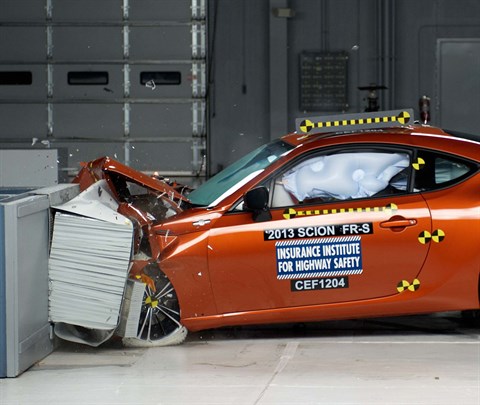
Action shot taken during the frontal offset crash test.
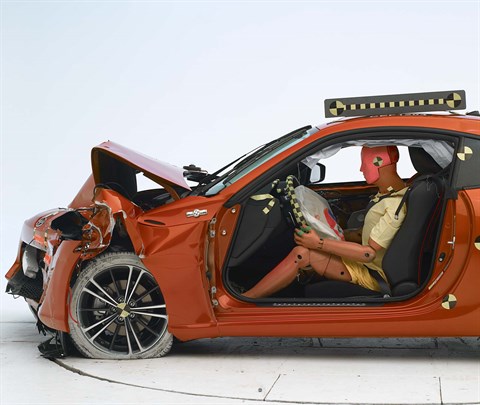
The dummy's position in relation to the steering wheel and instrument panel after the crash test indicates that the driver's survival space was maintained very well.
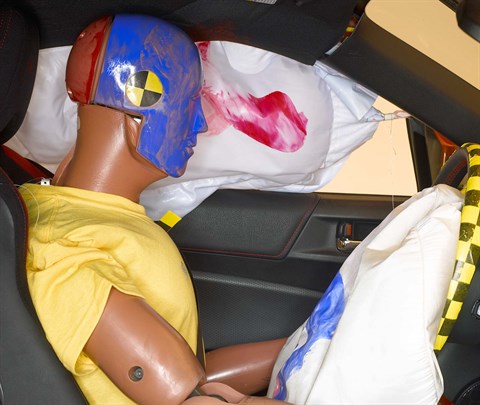
Smeared greasepaint shows where the driver dummy's head was protected from hitting hard structures during rebound by the side curtain airbag.

Intrusion into the driver's space was minimal, and all leg and foot injury measures were low.
Measures of occupant compartment intrusion on driver side
| Test ID | CEF1204 |
|---|---|
| Footwell intrusion | |
| Footrest (cm) | 5 |
| Left (cm) | 9 |
| Center (cm) | 9 |
| Right (cm) | 7 |
| Brake pedal (cm) | 2 |
| Instrument panel rearward movement | |
| Left (cm) | 0 |
| Right (cm) | 0 |
| Steering column movement | |
| Upward (cm) | 1 |
| Rearward (cm) | -1 |
| A-pillar rearward movement (cm) | 0 |
Driver injury measures
| Test ID | CEF1204 |
|---|---|
| Head | |
| HIC-15 | 158 |
| Peak gs at hard contact | no contact |
| Neck | |
| Tension (kN) | 1.0 |
| Extension bending moment (Nm) | 11 |
| Maximum Nij | 0.23 |
| Chest maximum compression (mm) | 27 |
| Legs | |
| Femur force - left (kN) | 0.2 |
| Femur force - right (kN) | 0.3 |
| Knee displacement - left (mm) | 1 |
| Knee displacement - right (mm) | 0 |
| Maximum tibia index - left | 0.37 |
| Maximum tibia index - right | 0.33 |
| Tibia axial force - left (kN) | 2.0 |
| Tibia axial force - right (kN) | 2.7 |
| Foot acceleration (g) | |
| Left | 87 |
| Right | 79 |
Side: original test
Rating applies to 2013-20 models
Tested vehicle: 2013 Scion FR-S 2-door with standard front and rear head curtain airbags and standard front seat-mounted torso airbags
The Scion FR-S and Subaru BRZ were introduced in the 2013 model year. The Scion FR-S was renamed the Toyota 86 beginning with the 2017 model year as Toyota discontinued the Scion nameplate.
| Overall evaluation | |
|---|---|
| Structure and safety cage | |
| Driver injury measures | |
| Head/neck | |
| Torso | |
| Pelvis/leg | |
| Driver head protection | |
| Rear passenger injury measures | |
| Head/neck | |
| Torso | |
| Pelvis/leg | |
| Rear passenger head protection | |
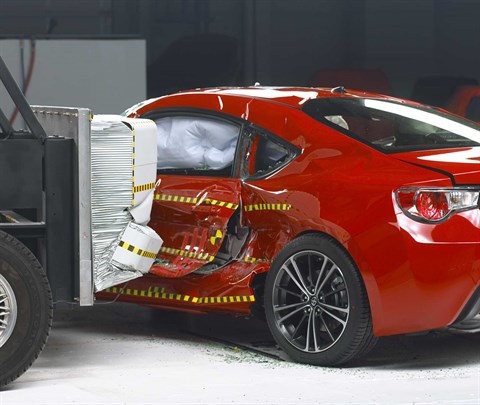
View of the vehicle and barrier just after the crash test.

View of the vehicle after the crash with door removed, showing the side airbags and damage to the occupant compartment.
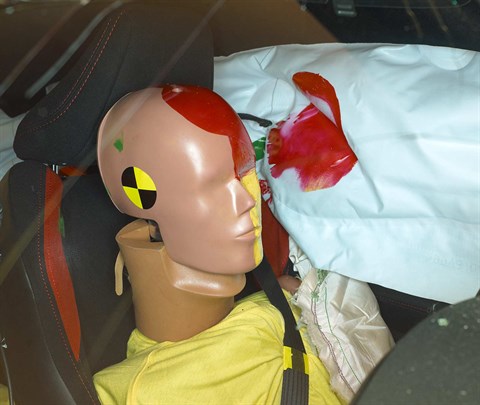
Smeared greasepaint shows where the driver dummy's head was protected from being hit by hard structures by the side curtain airbag (contact with the side torso airbag is not visible in this photo).
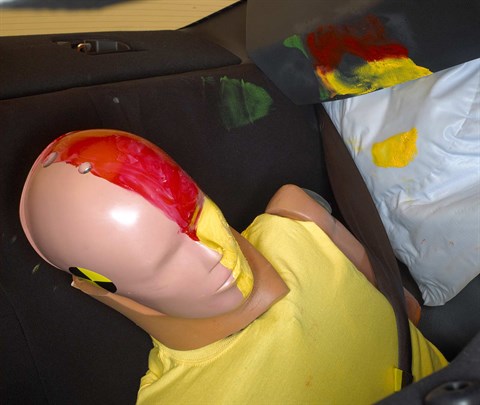
Smeared greasepaint shows where the rear passenger dummy’s head was protected by the side airbag (the C-pillar trim was dislodged by the inflating airbag and does not pose an injury risk).
Measures of occupant compartment intrusion on driver side
| Test ID | CES1207 |
|---|---|
| B-pillar to longitudinal centerline of driver's seat (cm) | -14.0 |
| Negative numbers indicate the amount by which the crush stopped short of the seat centerline. | |
Driver injury measures
| Test ID | CES1207 |
|---|---|
| Head HIC-15 | 168 |
| Neck | |
| Tension (kN) | 0.9 |
| Compression (kN) | 0.2 |
| Shoulder | |
| Lateral deflection (mm) | 40 |
| Lateral force (kN) | 1.3 |
| Torso | |
| Maximum deflection (mm) | 40 |
| Average deflection (mm) | 38 |
| Maximum deflection rate (m/s) | 4.74 |
| Maximum viscous criterion (m/s) | 0.78 |
| Pelvis | |
| Iliac force (kN) | 1.3 |
| Acetabulum force (kN) | 2.2 |
| Combined force (kN) | 3.2 |
| Left femur | |
| L-M force (kN) | 0.2 |
| L-M moment (Nm) | 141 |
| A-P moment (Nm) | 65 |
Passenger injury measures
| Test ID | CES1207 |
|---|---|
| Head HIC-15 | 235 |
| Neck | |
| Tension (kN) | 0.3 |
| Compression (kN) | 0.8 |
| Shoulder | |
| Lateral deflection (mm) | 40 |
| Lateral force (kN) | 1.4 |
| Torso | |
| Maximum deflection (mm) | 36 |
| Average deflection (mm) | 22 |
| Maximum deflection rate (m/s) | 2.38 |
| Maximum viscous criterion (m/s) | 0.49 |
| Pelvis | |
| Iliac force (kN) | 0.4 |
| Acetabulum force (kN) | 0.8 |
| Combined force (kN) | 1.1 |
| Left femur | |
| L-M force (kN) | 0.6 |
| L-M moment (Nm) | 70 |
| A-P moment (Nm) | -31 |
Roof strength
Rating applies to 2013-20 models
Tested vehicle: 2013 Scion FR-S 2-door
| Overall evaluation | |
|---|---|
| Curb weight | 2,787 lbs |
| Peak force | 13,941 lbs |
| Strength-to-weight ratio | 5.00 |
Head restraints & seats
Seat type: Manual cloth seats
| Overall evaluation | |
|---|---|
| Dynamic rating | |
| Seat/head restraint geometry |
| Seat type | Manual cloth seats |
|---|---|
| Geometry | |
| Backset (mm) | 22 |
| Distance below top of head (mm) | 24 |
| Seat design parameters | |
| Pass/fail | Pass |
| Max T1 acceleration (g) | 14.7 |
| Head contact time (ms) | 60 |
| Force rating | 1 |
| Neck forces | |
| Max neck shear force (N) | 0 |
| Max neck tension (N) | 464 |
About the head restraint & seat test
Currently, IIHS tests apply only to front seats.
Child seat anchors
Rating applies to 2016-17 models
| Overall evaluation | |
| Vehicle trim | Limited/Series.Blue |
| Seat type | suede |
This vehicle has 2 rear seating positions with complete child seat attachment (LATCH) hardware.
| Overall evaluation | |
| Vehicle trim | Limited/Series.Blue |
| Seat type | suede |
| G | Good |
| A | Acceptable |
| M | Marginal |
| P | Poor |
| Seating positions that rely on borrowed lower anchors or have only a tether anchor available are not rated. | |
thether anchor symbol | Tether anchor |
lower anchor symbol | Lower anchors |
| Lower anchor(s) can be borrowed from adjacent positions(s) | |
| No hardware available |
Details by seating position
| 1 | |
|---|---|
| Tether anchor | |
| easy-to-find location | |
| no other hardware could be confused for anchor | |
| Lower anchors | |
| too deep in seat | |
| too much force needed to attach | |
| difficult to maneuver around anchors | |
| 3 | |
| Tether anchor | |
| easy-to-find location | |
| no other hardware could be confused for anchor | |
| Lower anchors | |
| too deep in seat | |
| too much force needed to attach | |
| easy to maneuver around anchors |
Seat position 21
| Lower anchor A | |
|---|---|
| Open access rated | No |
| Depth (cm) | 4-6 |
| Force (lbs) | could not measure |
| Clearance angle (degrees) | 67 |
| Lower anchor B | |
| Open access rated | No |
| Depth (cm) | 4-6 |
| Force (lbs) | could not measure |
| Clearance angle (degrees) | 57 |
| Tether anchor | |
| Location | Rear deck |
| Confusing hardware present | No |
| Has contrasting label within 3 inches of tether anchor |
No |
| Tether anchors can be accessed while seatback is properly positioned for use of LATCH |
Not measured |
Seat position 23
| Lower anchor A | |
|---|---|
| Open access rated | No |
| Depth (cm) | 4-6 |
| Force (lbs) | could not measure |
| Clearance angle (degrees) | 53 |
| Lower anchor B | |
| Open access rated | No |
| Depth (cm) | 4-6 |
| Force (lbs) | could not measure |
| Clearance angle (degrees) | 60 |
| Tether anchor | |
| Location | Rear deck |
| Confusing hardware present | No |
| Has contrasting label within 3 inches of tether anchor |
No |
| Tether anchors can be accessed while seatback is properly positioned for use of LATCH |
Not measured |